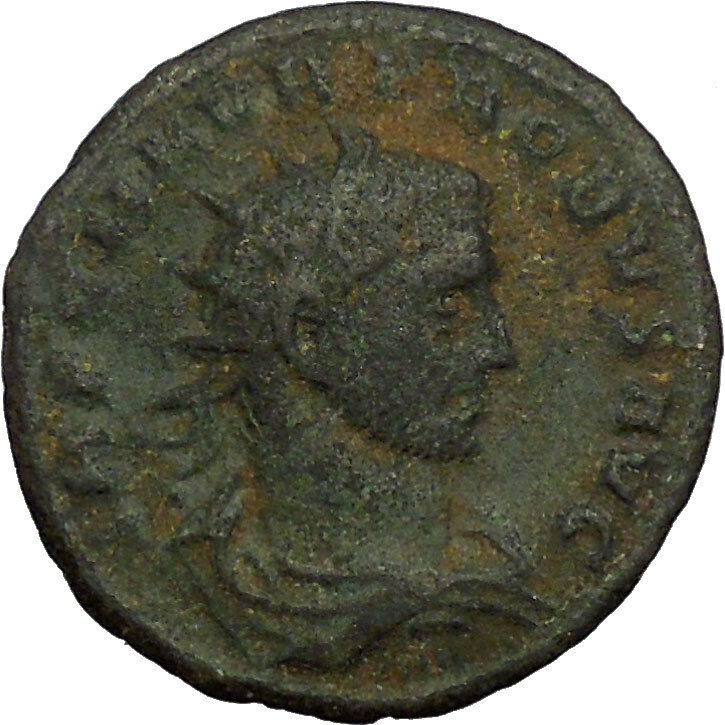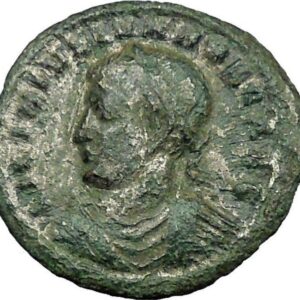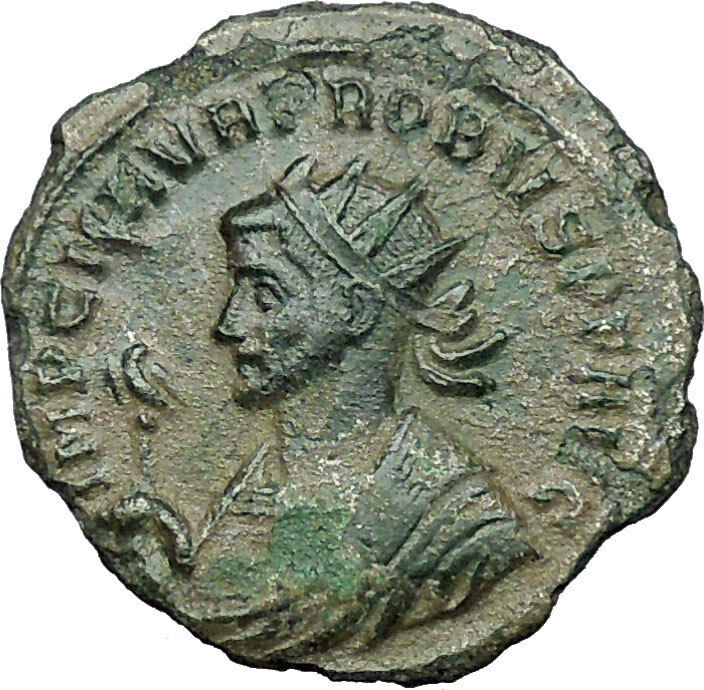Item: i30945


Coin of:
Licinius I – Roman Emperor: 308-324 A.D. –
Bronze Follis 22mm (2.95 grams) Thessalonica mint: 312-313 A.D.
Reference: RIC 57 (VII, Thessalonica)
IMPLICLICINIVSPFAVG – Laureate head right.
IOVICONSERVATORIAVG Exe: .TS.Γ. – Jupiter standing left, holding Victory on
globe
and scepter;
eagle with wreath in beak to left.
* Numismatic Note: The emperor is invoking Jupiter to preserve
his rule.
You are bidding on the exact item pictured,
provided with a Certificate of Authenticity and Lifetime Guarantee of
Authenticity.
Licinius I (Latin:
Gaius Valerius Licinianus Licinius Augustusc. 263 – 325), was
Roman Emperor from 308 to 324. For the majority
of his reign he was the colleague and rival of
Constantine I, with whom he co-authored the
Edict of Milan that granted official toleration
to Christians in the Roman Empire. He was finally defeated at the
Battle of Chrysopolis, before being executed on
the orders of Constantine I.

Sculptural portraits of Licinius (left) and his rival
Constantine I (right).
Early reign

Coin of Licinius I.
Born to a
Dacian
peasant family in
Moesia Superior, Licinius accompanied his close
childhood friend, the future emperor
Galerius, on the Persian expedition in 298.
He was trusted enough by Galerius that in 307 he was sent as an envoy to
Maxentius in
Italy to attempt to reach some agreement about
his illegitimate status.
Galerius then trusted the eastern provinces to Licinius when he went to deal
with Maxentius personally after the death of
Flavius Valerius Severus.
Upon his return to the east Galerius elevated Licinius to the rank of
Augustus in the West on November 11, 308. He
received as his immediate command the provinces of
Illyricum,
Thrace and
Pannonia.
In 310 he took command of the war against the
Sarmatians, inflicting a severe defeat on them
and emerging victorious.
On the death of Galerius in May 311, Licinius entered into an agreement with
Maximinus II (Daia) to share the eastern
provinces between them. By this point, not only was Licinius the official
Augustus of the west, but he also possessed part of the eastern provinces as
well, as the
Hellespont and the
Bosporus became the dividing line, with
Licinius taking the European provinces and Maximinus taking the Asian.
An alliance between Maximinus and Maxentius forced the two remaining emperors
to enter into a formal agreement with each other.
So in March 313 Licinius married
Flavia Julia Constantia, half-sister of
Constantine I,
at Mediolanum (now
Milan); they had a son,
Licinius the Younger, in 315. Their marriage
was the occasion for the jointly-issued “Edict
of Milan” that reissued Galerius’ previous edict allowing
Christianity to be professed in the Empire,
with additional dispositions that restored confiscated properties to Christian
congregations and exempted Christian clergy from municipal civic duties.[8]
The redaction of the edict as reproduced by
Lactantius – who follows the text affixed by
Licinius in
Nicomedia on June 14 313, after Maximinus’
defeat – uses a neutral language, expressing a will to propitiate “any Divinity
whatsoever in the seat of the heavens”.

Coin of Licinius
Daia in the meantime decided to attack Licinius. Leaving Syria with 70,000
men, he reached
Bithynia, although harsh weather he encountered
along the way had gravely weakened his army. In April 313, he crossed the
Bosporus and went to
Byzantium, which was held by Licinius’ troops.
Undeterred, he took the town after an eleven-day siege. He moved to Heraclea,
which he captured after a short siege, before moving his forces to the first
posting station. With a much smaller body of men, possibly around 30,000,[10]
Licinius arrived at
Adrianople while Daia was still besieging
Heraclea. Before the decisive engagement,
Licinius allegedly had a vision in which an angel recited him a generic prayer
that could be adopted by all cults and which Licinius then repeated to his
soldiers.[11]
On 30 April 313, the two armies clashed at the
Battle of Tzirallum, and in the ensuing battle
Daia’s forces were crushed. Ridding himself of the imperial purple and dressing
like a slave, Daia fled to
Nicomedia.
Believing he still had a chance to come out victorious, Daia attempted to stop
the advance of Licinius at the
Cilician Gates by establishing fortifications
there. Unfortunately for Daia, Licinius’ army succeeded in breaking through,
forcing Daia to retreat to
Tarsus where Licinius continued to press him on
land and sea. The war between them only ended with Daia’s death in August 313.
Given that Constantine had already crushed his rival Maxentius in 312, the
two men decided to divide the Roman world between them. As a result of this
settlement, Licinius became sole Augustus in the East, while his brother-in-law,
Constantine, was supreme in the West. Licinius immediately rushed to the east to
deal with another threat, this time from the Persian
Sassanids.
Conflict with
Constantine I
In 314, a civil war erupted between Licinius and Constantine, in which
Constantine used the pretext that Licinius was harbouring Senecio, whom
Constantine accused of plotting to overthrow him.
Constantine prevailed at the
Battle of Cibalae in
Pannonia (October 8, 314).[6]
Although the situation was temporarily settled, with both men sharing the
consulship in 315, it was but a lull in the
storm. The next year a new war erupted, when Licinius named
Valerius Valens co-emperor,
only for Licinius to suffer a humiliating defeat on the plain of
Mardia (also known as
Campus Ardiensis) in
Thrace. The emperors were reconciled after
these two battles and Licinius had his co-emperor Valens killed.
Over the next ten years, the two imperial colleagues maintained an uneasy
truce.
Licinius kept himself busy with a campaign against the Sarmatians in 318,
but temperatures rose again in 321 when Constantine pursued some Sarmatians, who
had been ravaging some territory in his realm, across the Danube into what was
technically Licinius’s territory.
When he repeated this with another invasion, this time by the
Goths who were pillaging
Thrace, Licinius complained that Constantine
had broken the treaty between them.
Constantine wasted no time going on the offensive. Licinius’s fleet of 350
ships was defeated by Constantine I’s fleet in 323. Then in 324, Constantine,
tempted by the “advanced age and unpopular vices”
of his colleague, again declared war against him, and, having defeated his army
of 170,000 men at the
Battle of Adrianople (July 3, 324), succeeded
in shutting him up within the walls of
Byzantium.[6]
The defeat of the superior fleet of Licinius in the
Battle of the Hellespont by
Crispus, Constantine’s eldest son and
Caesar, compelled his withdrawal to
Bithynia, where a last stand was made; the
Battle of Chrysopolis, near
Chalcedon (September 18), resulted in Licinius’
final submission.
While Licinius’ co-emperor
Sextus Martinianus was killed, Licinius himself
was spared due to the pleas of his wife, Constantine’s sister, and interned at
Thessalonica.
The next year, Constantine had him hanged, accusing him of conspiring to raise
troops among the barbarians.
Character and legacy
Constantine made every effort to blacken the reputation of his imperial
colleague. To this end, stories began circulating about Licinius’s cruelty. It
was said that he had put to death Severianus, the son of the emperor Severus, as
well as Candidianus, the son of Galerius.
To this was added the execution of the wife and daughter of the Emperor
Diocletian, who had fled from the court of
Licinius before being discovered at
Thessalonica.
Much of this can be considered imperial propaganda on the part of Constantine.
In addition, as part of Constantine’s attempts to decrease Licinius’s
popularity, he actively portrayed his brother-in-law as a pagan supporter. This
was not the case; contemporary evidence tends to suggest that he was at least a
committed supporter of Christians.
He co-authored the Edict of Milan which ended the
Great Persecution, and re-affirmed the rights
of Christians in his half of the empire. He also added the Christian symbol to
his armies, and attempted to regulate the affairs of the Church hierarchy just
as Constantine and his successors were to do. His wife was a devout Christian.
It is even a possibility that he converted.
However,
Eusebius of Caesarea, writing under the rule of
Constantine, charges him with expelling Christians from the Palace and ordering
military sacrifice, as well as interfering with the Church’s internal procedures
and organization.
According to Eusebius, this turned what appeared to be a committed Christian
into a man who feigned sympathy for the sect but who eventually exposed his true
bloodthirsty pagan nature, only to be stopped by the virtuous Constantine.
Finally, on Licinius’s death, his memory was branded with infamy; his statues
were thrown down; and by edict, all his laws and judicial proceedings during his
reign were abolished
In
Roman mythology,
Jupiter or
Jove was the
king of the gods, and the god of
sky and
thunder. He
is
 the equivalent of
the equivalent of
Zeus in the
Greek pantheon. He was called Iuppiter (or Diespiter)
Optimus Maximus (“Father God the Best and Greatest”). As the patron deity of
ancient
Rome, he ruled over laws and social order. He was the chief god of the
Capitoline Triad, with sister/wife
Juno. Jupiter is also the father of the god
Mars with Juno. Therefore, Jupiter is the grandfather of
Romulus and Remus, the legendary founders of Rome. Jupiter was venerated in
ancient Roman religion, and is still venerated in
Roman Neopaganism. He is a son of
Saturn, along with brothers
Neptune and
Pluto.
He is also the brother/husband of
Ceres (daughter of Saturn and mother of
Proserpina),
brother of
Veritas (daughter of Saturn), and father of
Mercury.
Your browser does not support JavaScript.
To view this page, enable JavaScript if it is disabled or upgrade your browser.
Frequently Asked d Questions
How long until my order is shipped?:
Depending on the volume of sales, it may take up to 5 business days for
shipment of your order after the receipt of payment.
How will I know when the order was shipped?:
After your order has shipped, you will be left positive feedback, and that
date should be used as a basis of estimating an arrival date.
After you shipped the order, how long will the mail take?
USPS First Class mail takes about 3-5 business days to arrive in the U.S.,
international shipping times cannot be estimated as they vary from country
to country. I am not responsible for any USPS delivery delays, especially
for an international package.
What is a certificate of authenticity and what guarantees do you give
that the item is authentic?
Each of the items sold here, is provided with a Certificate of Authenticity,
and a Lifetime Guarantee of Authenticity, issued by a world-renowned numismatic
and antique expert that has identified over 10000 ancient coins and has provided them
with the same guarantee. You will be quite happy with what you get with the COA; a professional presentation of the coin, with all of the relevant
information and a picture of the coin you saw in the listing.
Compared to other certification companies, the certificate of
authenticity is a $25-50 value. So buy a coin today and own a piece
of history, guaranteed.
Is there a money back guarantee?
I offer a 30 day unconditional money back guarantee. I stand
behind my coins and would be willing to exchange your order for
either store credit towards other coins, or refund, minus shipping
expenses, within 30 days from the receipt of your order. My goal is
to have the returning customers for a lifetime, and I am so sure in
my coins, their authenticity, numismatic value and beauty, I can
offer such a guarantee.
Is there a number I can call you with questions about my
order?
You can contact me directly via ask seller a question and request my
telephone number, or go to my
About Me Page to get my contact information only in regards to
items purchased on eBay.
When should I leave feedback?
Once you receive your
order, please leave a positive. Please don’t leave any
negative feedbacks, as it happens many times that people rush to leave
feedback before letting sufficient time for the order to arrive. Also, if
you sent an email, make sure to check for my reply in your messages before
claiming that you didn’t receive a response. The matter of fact is that any
issues can be resolved, as reputation is most important to me. My goal is to
provide superior products and quality of service.
Your browser does not support JavaScript.
To view this page, enable JavaScript if it is disabled or upgrade your browser.






